In the United States, about 2 million people experience injuries due to a CMV crash. Although there are many causes for accidents such as roadway problems, brake issues, speeding, distracted driving, and more, the most common cause is truck driver fatigue.
The 34-hour reset is one of the rules designed to help reduce fatigue and allow drivers and companies to allocate their hours responsibly.
What is the 34-hour restart rule?
In 2017, the Federal Motor Carrier Safety Administration (FMCSA) updated their hours of service (hos) rules, and one of the major updates is the 34- hour reset rule. It’s important to understand some of the driver statuses that go into the hours of service logging.
- On-Duty: The truck driver is working; however, they aren’t driving. They are performing other tasks like unloading, inspecting, or fueling.
- Off-Duty: The driver isn’t working.
- Driving: The driver is on the road.
- Sleeper Berth: To prevent driver fatigue, drivers are allowed to rest in their cab.
The goal of the 34-hour restart rule is for truck drivers to reset their driving cycle if they’re close to reaching the maximum capacity for the number of hours allowed for driving and on-duty. For instance, the maximum a driver can stay on-duty is 70 hours per eight days or 60 hours within a seven-day time frame.
With the 34-hour reset rule, drivers can strategically reset their workweek by taking a 34-hour breakthrough the sleeper berth or off duty. Once the 34-hour break is completed, the driver may hit the road again. This means that the clock is reset back to zero, and the driver is free to start driving the allocated number of hours.
Why is there a 34-hour restart rule?
Although the 34-hour reset rule seems arbitrary, it’s chosen for a specific reason. The FMCSA found that 34 hours provides enough flexibility for trucking companies to operate their fleet efficiently while still giving drivers a break so that they can feel rejuvenated.
Through studies, they found that a 34-hour break reduced any effect of fatigue and exhaustion, which results in fewer accidents. Anything under 34 hours would be very inflexible for a trucking company to schedule sufficient breaks. They would not be able to justify these breaks from an economic or safety standpoint.

Are Truck Drivers Required to Follow the 34-Hour Restart Rule?
It’s important to note that this is just one rule that can be used to help manage driver’s hours and allows trucking companies to better plan their fleet’s schedule. However, the 34-hour restart rule isn’t mandatory. Nevertheless, depending on your drivers, the 34-hour restart provision may be the fastest way to reset their workweek and hop back on the road.
Where Can Truck Drivers Take Their 34-Hour Breaks?
It’s a common misconception within the trucking industry that it requires the driver only to take the 34-hour break while being at home. However, according to the hours o service regulations, this 34-hour reset can be taken anywhere, so long as they log this off-duty utilizing the time zone of their home terminal. In short, this means if your company resides in a PST time zone, they must also log their break history in the PST time zone.
Drivers can also take their 34-hour breaks in their trucks’ sleeper berth. However, they must be in compliance with an additional rule. Drivers who want to use their sleeper berth for part of their restart must take a minimum of eight hours into their sleeper berth. Drivers can split these eight hours into two breaks if they choose to. The remaining 26 hours of break time can be taken anywhere.
Is There Specific Times that Truckers Should Take Their 34-Hour Breaks?
According to hours of service (hos) rules, when drivers reach the driving limit, they are free to take their 34-hour restart break.
The confusion has to do with the previously implemented 34-hour restart rule implemented on July 1st of 2013 by the FMCSA. But thanks to the Omnibus Appropriations Bill 2015 created by Congress in 2015, that version no longer applies to any provisions.
2013 that is now voided initially required:
- The 34-hour rule must contain two separate periods between 1 a.m. to 5 a.m. for the driving clocks to be reset.
- A restart could only be done one time every 168 hours.
However, the DOT made changes to these rules because they recognized that these stipulations simply didn’t help the safety of the drivers.
Now drivers are allowed to take the 34-hour break wherever they choose, but they just need to ensure they log this information into their ELD or logbook.

Are There Any Exceptions to the Restart Rule for Commercial Motor Vehicle Drivers?
When it comes to following the hos regulations, most of the confusion revolves around the exceptions of the rule: what counts and what doesn’t count towards your electronic or paper logs. For example, to use the 34-hour restart rule, you need to know how many hours your drivers work within a seven or eight-day time period.
Here are three of the most common exceptions regarding the hos regulations:
Short-haul drivers: According to the DOT, truck drivers traveling within a 100 air-mile radius of their typical home terminal may be eligible to log their hours with a time card instead of using an ELD. Unfortunately, these drivers may not exercise the 34-hour restart rule because they are exempt from HOS provisions.
Personal Use: If drivers frequently use vehicles for personal use, then this time should be logged as Off-Duty for a trucking company. However, this time is tracked on an ELD but won’t add to the total HOS. This means personal time won’t count towards your normal 70 hours of on-duty time.
Yard moves: If trucking companies ask drivers to move their vehicles to a different spot in the job site or yard, this wouldn’t have any effect on the log times. This is because the FMCSA and DOT have specified that yard moves don’t count towards any log times.
The DOT thoroughly regulates these hours of service regulations. Make sure to read the FMCSA guidelines to see if the driver can support the 34-hour reset rule.
How Do You Log the 34 Hour Restart?
With paper logs, it would be tedious for drivers to log the driver statuses and for a trucking company to check the validity of these logged hours. That’s why the FMCSA and DOT have fully implemented the hos provisions to require the use of ELDs.
However, a company that manages a fleet must choose a quality vendor and solution to track their driver’s statutes in real-time accurately. Reliable ELD’s will offer real-time insights to assist truckers in avoiding violations and help logistics managers plan routes optimally.
What happens if you unplug your ELD?
Drivers may be tempted to unplug their ELD, especially during their 34 hour rest period. However, this is a bad idea. By unplugging the ELD, it will be disconnected and no longer be tracking information. However, the ELD fleet device will generate an error log that notes the changes of when the last time, date, and location is recorded.
In fact, many ELD devices will send alerts to the fleet manager when unplugged. In addition, changes in sporadic errors or changes in the log will raise red flags and trigger audits.
Even when you’re resting, the ELD will indicate that the vehicle didn’t move and stayed stationary the entire time. This helps to guarantee that the clocks will reset. If the ELD is unplugged, the driver will be held responsible for possible fines, license suspension, or termination.
Can You Use Personal Conveyance During a 34-Hour Reset?
Personal conveyance is a term that is used in regulations and can otherwise be known as personal use. This means a driver who uses a commercial motor vehicle for transportation is unrelated to their work responsibilities.
Since personal conveyance is counted as off-duty time, it can also be counted towards the total 34 hour restart time.
Final Thoughts
The FMCSA implements rules to ensure the safety of all commercial motor vehicle drivers and the other drivers on the road. The 34-hour restart rule prevents driver fatigue, so they are refreshed to begin their next driving cycle.

1 thought on “Guide to FMCSA’s 34-Hour Reset Rule”
Im very happy to find this web site. I want to to thank you for ones time just for this fantastic read!! I definitely appreciated every part of it and i also have you saved as a favorite to see new information in your blog.